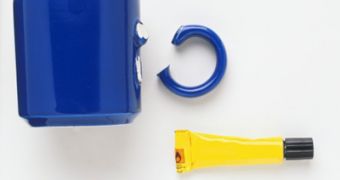Superglue is a cyanoacrylate substance known as ethyl-2-cyanoacrylate, which is generally sold around the world as instant adhesive mostly under the name of 'Superglue'. It was first discovered by Harry Coover from Kodak during the World War II while he was trying to make gun-sight lenses out of it, although he never succeeded due to the sticky nature of the compound. More than five decades ago, cyanoacrylates were first used to create the instant adhesive we now call superglue and that was back then commercialized under the name of 'Flash Glue'.
Its primary use is as an adhesive, creating highly strong bonds with non-porous materials and even those containing traces of water. Alternatively, cyanoacrylates are extremely great at gluing living biological tissue although their everyday use for such purposes may sometimes prove somehow dangerous. Superglue has a low shearing strength, resists water remarkably well, bonds metals and even coral to rocks.
Not all cyanoacrylates are adhesive, some of which are used by criminal investigation teams to collect finger prints. Cyanoacrylate glues can also be used in thin layers to give wood a glossy finish, although the method is somehow expensive and leaves behind a nightmare of a mess.
A couple of decades after cyanoacrylates were developed, Kodak started experimenting with superglues in medicine, especially in bonding living tissue after a surgery. To everybody's surprise, the cyanoacrylate has a remarkable capability of stopping the bleeding of the tissue, which saved a lot of lives during the Vietnam War when cyanoacrylates were already found in the form of sprays throughout the battlefield.
Cyanoacrylates have a liquid form in normal atmospheric conditions, a flashpoint of about 75 degrees Celsius and a density slightly higher than that of water. In the presence of water it forms long chains of acrylic resin connecting the two surfaces needed to be bonded. In fact moisture in the air is what makes it turn solid when left exposed.
The bond created by cyanoacrylates reaches maximum strength within two hours since it was set, can be generally softened with acetone while in low temperatures already set cyanoacrylates turn brittle. The application of cyanoacrylates on cotton must be avoided at all time, since the reaction between the two is violent and can result in fire hazards and mild irritations from smoke.
Superglue is non-toxic, although it does have an irritating effect on the eyes and can trigger asthma in rare situations.

 14 DAY TRIAL //
14 DAY TRIAL //